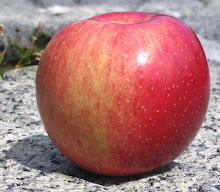 |
Most apples sold in stores are waxed for appearance, and also to protect and preserve the fruit.
Like many fruits and vegetables, apples produce their own waxy coating that sheds water and retains moisture.
Apples direct from an orchard aren't washed (usually) or waxed. Many organic growers also do not wax their fruits.
For the most part, these waxes are from other plants. Carnauba wax, from a Brazilian palm tree, is popular, but approved waxes also include candellia wax, from another plant, and even food-grade petroleum-based wax.
There are dairy- or animal-based waxes, but these do not seem to be in actual use in North America; fruit treated with these waxes is supposed to be identified as such.
And then there is a kind of shellac, which does seem to be popular. As the Washington State Apple Commission says,
The natural wax added to protect Washington apples is usually carnauba or shellac. Both are approved by the U.S. Food and Drug Administration and have been used on a variety of foods for decades. These wax formulations are natural, non-petroleum based coatings.
So, about this shellac. The U.S. Apple Association, another industry group, has information about that, and I'm afraid I'm going to have to use a word that I just hate to apply to any food, let alone apples. The waxes
come from natural sources including carnauba wax, from the leaves of a Brazilian palm; candellia wax, derived from reed-like desert plants of the genus Euphorbia; and food-grade shellac, which comes from a secretion of the lac bug found in India and Pakistan.
That word I hate to use is, yuck. The U.S. Apple Association valiantly explains these waxes "are also approved for use as food additives for candy and pastries;" Washington Apple Commission call this stuff "natural, non-petroleum based."
Sorry; I know this is a stupid cultural prejudice, and yeah, I eat honey, but this is the S word (secretions). From bugs.
If you are tempted to plumb the further depths of yuck, Bangelapedia has more information about the Lac insect, including a sketch. But if, gentle reader, you'd rather not go there, take a few deep breaths an retreat with me into more abstract realms.
For instance, the word "lac," from Sanskrit, lends itself both to "shellac" and "lacquer" (lac is the source of both substances).
Then reflect that the quantities of waxes used are small, and avoidable altogether if you go organic or buy direct from growers. And have an apple. It always helps me.

"The natural wax added to protect Washington apples is usually carnauba or shellac. "
ReplyDeleteWhat worries me even more is the word, "usually." Usually carnauba or shellac??? Not either/or. This makes me wonder what other coatings that they use that they are not telling us about?
It's interesting that they sort of classify shellac as a wax - I don't believe it is. It's more of a resin, really. As a beekeeper familiar with beeswax and a woodworker familiar with shellac, I'd have to say that though my preference is for the unwaxed apples we grow ourselves, it doesn't weird me out to eat an apple with a bit of shellac on it (I might prefer that over some of the other waxes). Though if it did bother me, it would be because of the people doing the initial processing of the lac, not the lac bug secretion so much. I won't elaborate for your sensitive readers but it is a hands-on process.
ReplyDeleteBy the way - in case anyone is thinking of shellacking some apples, make sure to mix your own shellac flakes with drinking alcohol - the denatured alcohol used in shellac for wood finishing is what makes it not food grade (poisonous).
Thank you, Steve! Of course apples make their own wax, too; some varieties have a naturally greasy feeling from wax made by the apple.
DeleteHere's a close up from a reader.
I thought there was a Calvin and Hobbes cartoon on the bee secretions (honey, that is, not wax), but I can’t find it, so I must be misremembering.
ReplyDelete